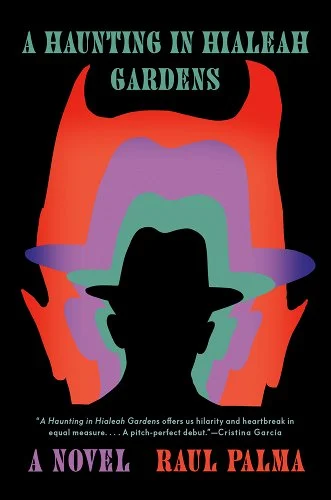We live in a moment where debt invokes the crushing weight of student loans, medical bills, mortgages, and all the other unsustainable systems that scaffold our world. These debts hang over us, invisible, exerting pressure and power over our lives, yet even in contemporary literature, with few exceptions, many fiction writers tend to overlook the subject of debt. This is why when I began writing A Haunting in Hialeah Gardens, I wanted Hugo’s debt to be abrasively visible—an entity that would fall into bed with him, caress him, poke him mid-conversation.
Early in drafting my novel, I revisited novels of the 19th century—a time when debt was a popular subject. Many writers, like Charles Dickens, underscore the perils of falling into debt; in their time, they sought to reform debt collection practices. What 19th century fiction shows us is that if you overextend your finances, you’ll ruin your life, unless you can be saved or forgiven by a creditor. What comes through is a treatment of debt that squarely situates the debtor in a position where if they don’t work hard enough, invest smart enough, or come into good fortune, they are cast aside as other.
We see this sort of framework realized on the national stage. When student loan forgiveness comes up, what we often hear from those in the opposition is that borrowers should have made better choices. When folks discuss the challenges that a younger generation is having in affording a mortgage (due to debt-income ratios), the younger generation is accused of being lazy, difficult to work with, and irresponsible (too many visits to the café, or too many orders of avocado toast, or not enough hard work). The result, almost always, is that the debtor comes to experience regret or shame.
What I want to believe, however, is that we can expand the way we think about debt. The capacity to owe something to someone or something is a gift—the first step in nurturing a family, a community, a sustainable planet. The joy in writing A Haunting in Hialeah Gardens was exploring this idea: how Hugo’s desire to be free from his monetary debts conflict with his emotional attachment to what his debt represents. There are times when Hugo isn’t even sure he wants forgiveness; he wonders, does his creditor really have the power to forgive him?
Here’s a list of seven contemporary and somewhat contemporary stories, highly recommended, that complicate what it means to live having fallen into debt, each of which my novel is in conversation with.
Mean Spirit by Linda Hogan
Mean Spirit is a work of historical fiction set in the early 1920s when the displaced Osage Nation found oil beneath their new land. Overnight, a people accustomed to living sustainably and in communion with the land became millionaires, and this new kind of wealth brought many problems from within their community and outside. Told as a murder mystery, Mean Spirit follows Stace Red Hawk, a government official summoned to investigate the murder of Grace Blanket, a very wealthy Osage Indian survived by her daughter, Nola. Through Stace, we see that the surrounding colonizers, previously concerned with exploiting land, have shifted their attention to exploiting the Osage people by infantilizing them, murdering them, and marrying them. As the Osage people fall into debt, they must quickly become savvy in money management, at the same time that they realize they must find a path back to their roots—a powerful book, full of magic, that shows how debt was weaponized by the colonizers.
The Rock Eaters by Brenda Peynado
Brenda Peynado’s debut short story collection is such a powerful look of immigration, power, and resistance across sixteen stories that span a multitude of sub-genres, from literary realism to science fiction and magical realism. These stories explore what we owe to our histories and to one another. The story “We Work in Miraculous Cages,” most explicitly contends with debt. It follows a young woman saddled with student loans and credit card debt, consigned to a life working multiple jobs (at a hair salon and a veterinary clinic) as she navigates a relationship and tries to make a path toward being free from her financial obligations—a heartbreaking look into the way our debts can arrest us in an economic system masquerading as a community, while, simultaneously, making us all foreign to one another.
How Not to Drown in a Glass of Water by Angie Cruz
Set during the sub-prime mortgage crises, How Not to Drown in a Glass of Water is a novel that follows Cara as she sits through a series of interviews with an unemployment office—a requirement so that she can continue to receive unemployment checks. Through Cara, we hear stories about a larger community that is struggling to make a life, whether they’re priced out of home buying or pressured into taking on whatever job arises to simply make ends meet. In the process, we learn about Cara’s early life in the Dominican Republic, her complex familial history, and we catch glimpses of her love for the community in Washington Heights—a community that is at-risk of being replaced by a younger, wealthier, whiter population. Beautifully rendered, this novel presents working-class challenges while offering hope.
The Magic of Blood by Dagoberto Gilb
The Magic of Blood is a collection of working-class short stories set in the Southwest, with a razor-sharp focus on debt, labor, and power. The opening story, “Look on the Bright Side,” tells the story of a tenant who takes his landlord to court when the rent is raised beyond the legal limit, and though he wins the case, he ultimately gets evicted anyway. Many stories in the collection follow this theme, with protagonists that sometimes seek justice by resisting the systems that they live under, yet they are still crushed in the end. What The Magic of Blood shows is how characters negotiate their relationships and identities, while facing down the pressures of the labor market and working to affirm their lives.
Super Sad True Love Story by Gary Shteyngart
In this hilarious satire, Gary Shteyngart offers a dystopic portrait of the United States in the “zero hour” of their economy, as Chinese ships enter New York Harbor to collect on US debts. Framed by an unlikely love story, we follow Lenny Abramov, 39-years old, a man nostalgic for simpler times—like when books were bound and made of paper. We also follow his partner Eunice Park, 24-years old—a young woman consumed by technology. They gravitate to one another for companionship and security; however, in a society brimming with security, surveillance, and creditors, they struggle to really connect and build a life together. This is a smart book that takes the logic of US dependency on technology and credit to its final conclusions.
Never Let Me Go by Kazuo Ishiguro
As Kathy H. faces down her own mortality, she recalls her life in Hailsham, a school for cloned children, who as adults will be expected to donate their organs to the people who commissioned their existence. What starts out as a novel veering toward resistance and rebellion, becomes a story about finding dignity in settling one’s debts and coming to terms with the cost. This novel raises many ethical questions about the ways that money and power can create hierarchies that privilege some forms of life over others.
The Neverending Story by Michael Ende, translated by Ralph Manheim
Thanks to the film, most people are familiar with The Neverending Story’s opening act, which culminates with Bastian giving the Childlike Empress a new name and stopping The Nothing. In the often overlooked second act, Bastian finds himself in a world that is a blank slate, and he is given the task of remaking the world by wishing it into existence. The catch, however, is that every time he makes a wish, it costs him a part of his memory. As Bastian brings the world of fantasy back to life, he forgets his friends, his family, and he loses his sense of self. Even when he recognizes the dangers of over-wishing, he cannot help but continue to spend his memories. Overextended in a currency of wish-making, Bastian loses his humanity and falls into anger, rashness, and a hunger for power. Bastian’s debt to the AURYN (wish maker) becomes unpayable until Bastian’s friends help. Michael Ende’s sophisticated play on narrative holds, at its center, a lesson about what we lose when we forget (or can’t see) what we owe our loved ones.

